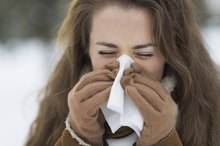Skin Rashes and Allergies to Soy
Skin rashes are a common symptom of a food-related allergy. These rashes typically appear within a few minutes after eating a food to which you’re allergic. One of the most common food allergens is soy. This product of soy beans is a common ingredient in baked goods, cereals and processed meats. If you experience a rash after eating soy products, consult your doctor.
If you are experiencing serious medical symptoms, seek emergency treatment immediately.
Cause of Allergic Skin Rash
Increased levels of histamine in the blood can cause allergic rashes. If your immune system mistakenly identifies the proteins in soy as a dangerous substance, it begins to attack, notes MedlinePlus. Your immune system creates antibodies to ward off the proteins, and the antibodies cause mast cells to increase the production of histamine. Once histamine reaches the skin, it can cause inflammation, irritation and swelling.
Common Skin Rashes
Can Milk Thistle Cause Skin Rashes?
Learn More
The most common skin rashes from an allergy to soy are hives, eczema and general itching, according to the Mayo Clinic. Hives are welts that appear in clusters anywhere on the body. They are flat on top and have defined borders, but differ in shape in size. Hives are extremely itchy and are made worse by scratching. Eczema appears as raw patches or as small, raised bumps that can weep and crust over. In severe cases, eczema can leave permanent scars.
Treatment
The most effective treatment for skin rashes from an allergy to soy is to avoid consuming foods that contain this product. The American Academy of Allergy, Asthma and Immunology notes that allergic skin rashes can be treated with topical steroid creams, such as hydrocortisone or corticosteroids. These creams calm the skin, reduce swelling and alleviate the itch. An oral antihistamine also might help treat allergic skin rash.
Avoidance
Symptoms of Allergies to Chickpeas and Soy
Learn More
Avoid consuming soy products by reading the labels of prepackaged foods. The FDA requires food manufacturers to clearly state on the label if a product contains soy.
Warning
A severe allergic reaction to soy could lead to death. Anaphylactic shock, a severe allergic reaction, might start with hives, but other symptoms can develop quickly after that. Common symptoms include shortness of breath, increased heart rate, faint pulse, dizziness and mental confusion. A person suffering from anaphylactic shock may require an injection of epinephrine. Call 911 if you experience any of these symptoms.
Related Articles
References
Writer Bio
Diane Marks started her writing career in 2010 and has been in health care administration for more than 30 years. She holds a registered nurse license from Citizens General Hospital School of Nursing, a Bachelor of Arts in health care education from California University of Pennsylvania and a Master of Science in health administration from the University of Pittsburgh.









